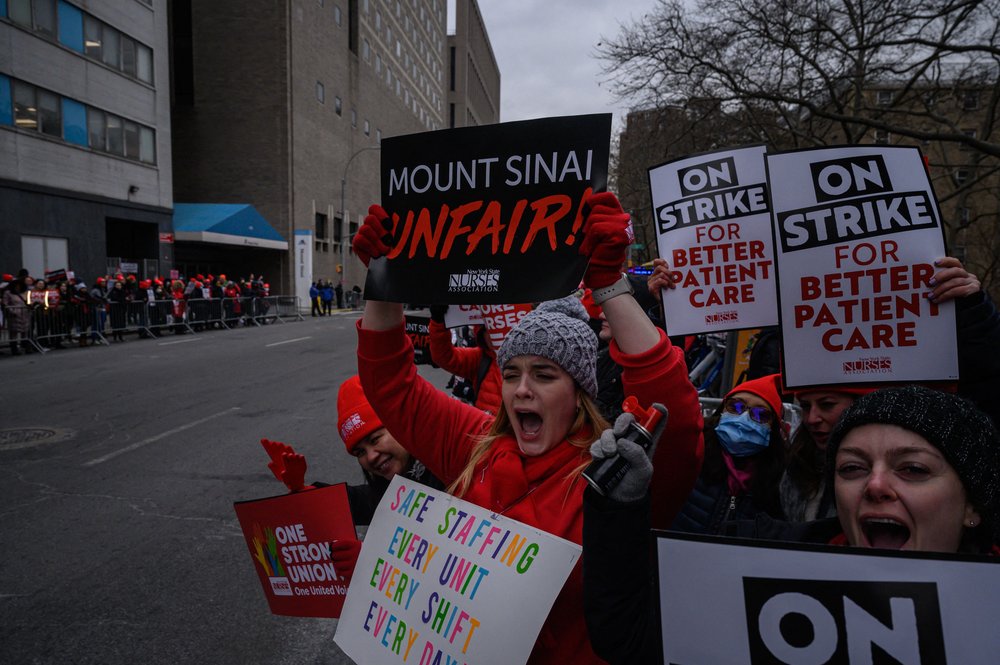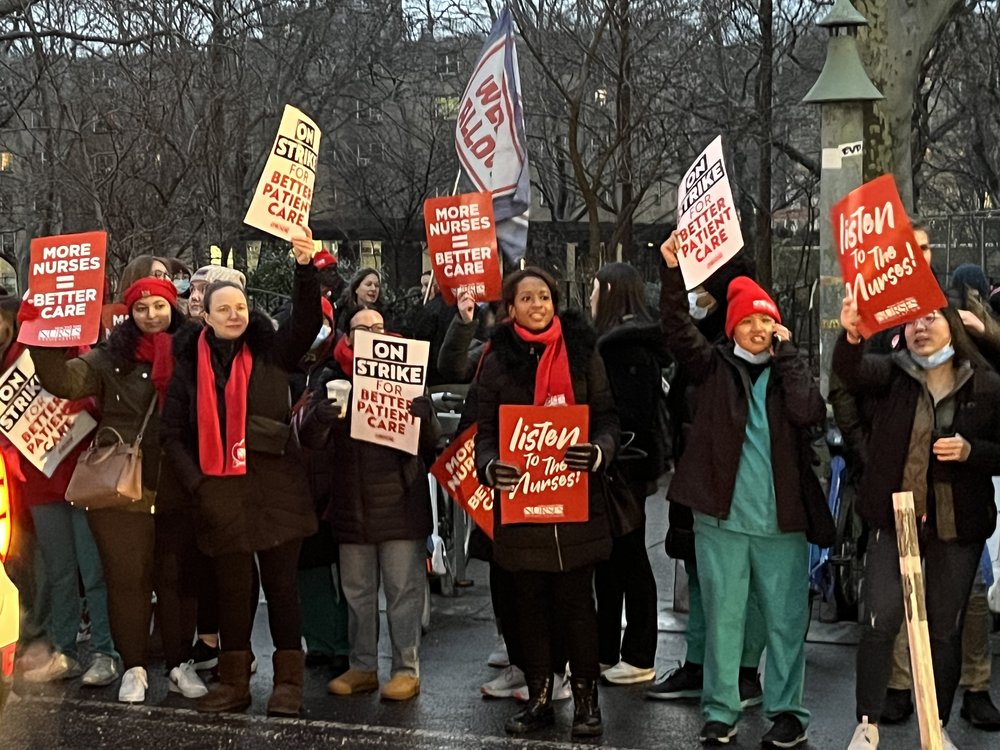Nurses detail turmoil inside NYC hospitals amid strike: ‘People don’t know what they’re doing’
Jan. 10, 2023, 6:19 p.m.
Sources described out-of-practice physician assistants triaging patients, non-union nurses working marathon shifts and ambulances stuck in traffic.

Out-of-practice physician assistants triaging patients, non-union nurses working marathon shifts and ambulances stuck in traffic. An ongoing strike by more than 7,000 nurses in New York City is pushing remaining staff across two hospitals to the limit as they try to maintain basic operations.
Gothamist spoke to five nurses at Mount Sinai Hospital in Manhattan and Montefiore Medical Center in the Bronx since picketing began early Monday about what it’s like on the inside. The union nurses’ demands center on pay and staff to patient ratios.
While the New York State Nurses Association members take to the streets, the units where they normally work have become more chaotic, several nurses said. The nurses, who asked to remain anonymous because they were not authorized to speak about working conditions, described inexperienced staff involved in high-stakes treatment of premature babies and intensive care unit patients.
Two nurses at Mount Sinai Hospital told Gothamist that all of the hospital’s roughly 120 newborn intensive care unit nurses and nurse practitioners are on strike. The NICU ward has roughly 60 beds for critically ill or premature newborn babies, one nurse said.
One nurse who is on strike and works in the NICU said she was told by non-union nurses they are being offered an hourly rate more than five times what a staff nurse makes – $300 an hour versus $52 an hour.
Lucia Lee, a spokesperson for Mount Sinai, confirmed that 36 infants were in the NICU as of Tuesday evening. She said the unit was “appropriately staffed” with 17 agency nurses. Lee declined to address the pay for non-union nurses in the unit.
NICU doctors were getting reacquainted with duties normally assigned to NICU nurses, such as feeding the babies, taking vitals and administering medication, the NICU nurse said.
“It’s extremely scary,” the NICU nurse said. “My colleagues and I were literally nauseous and unable to sleep leading up to this strike decision.”
Another nurse at Mount Sinai told Gothamist that just three ICU nurses showed up to work on Monday. There are normally seven or eight ICU nurses on the floor, she said.
“No relief nurses have shown up,” she said, but some non-clinical staff were lending a hand.
"If it weren’t for that, I wouldn't have gotten to eat today or gotten any breaks," she told Gothamist on Monday.

Each ICU nurse at Mount Sinai Hospital was expected to care for four critically ill patients at a time as of 6 a.m. on Monday, she said, based on instructions from hospital administrators.
Normally, ICU nurses care for one or two patients at a time, she said.
She was also instructed to work five consecutive days this week, compared to the usual two to three days in a row. Shifts were lasting 13 to 14 hours “if all goes well,” she said.
Multiple sources told Gothamist that on some of Mount Sinai’s surgical floors, no nurses showed up on Monday.
"When someone's heart stops, the ICU nurses usually go to those floors to help out. But if we only have three nurses, we basically have to weigh the outcomes,” the nurse said. “People die in those outcomes."
Lee, the Mount Sinai spokesperson, said the hospital could not confirm the count of absent nurses on any given floor as the situation was evolving “hour by hour.”
Lee added that Mount Sinai West and Morningside campuses were working to support the main campus in East Harlem, which has 1,172 inpatient beds. Those campuses ratified their contracts on Tuesday afternoon. Redeployments from other hospitals in the Mount Sinai system were happening on an hourly basis, she said.
A nurse-midwife at Mount Sinai said the hospital felt “very unsafe” because nurses were being assigned to floors they’ve never worked on before.
“People don’t know what they’re doing because they have not been oriented … they don’t know where things are,” the nurse-midwife said.
This was especially dangerous in emergency situations, like if a baby’s umbilical cord cuts off oxygen during labor, she said.
“When we have 20 nurses on the floor and lots of other staff who work well together, we are able to get babies delivered safely in those situations within minutes,” she said. “I can’t imagine that people who have never worked the floor can manage a stat situation like that as quickly as it needs to be handled."
She added, “In labor and delivery, things go from zero to 100 really quickly. It’s really frightening to think about.”
A bone marrow transplant nurse at Mount Sinai told Gothamist that the hospital’s oncology department directors were caring for cancer patients because there aren’t enough nurses on the floor.
“[The directors] are usually never on the floor,” the nurse said.
Mount Sinai Hospital was accepting ambulances on Tuesday, but diverting complex cases like strokes to other hospitals, according to an email that Mount Sinai President David Reich sent to staff and obtained by Gothamist. Reich said that the hospital was moving ER patients to other hospitals if they can be safely transferred.
Brandon Adams, an EMT lieutenant covering East Harlem who is a member of the EMS union, said physician assistants who aren’t normally in the ER were filling in for nurses and triaging patients arriving in ambulances to Mount Sinai. They determine how critical a patient is, and which doctors and tests they need urgently.
"If you don't triage a patient on a regular basis, that's definitely not a good thing,” Adams said. “Suddenly you're a substitute teacher.”
Adams said one of his EMTs warned other crews to “stay away” from Mount Sinai Hospital after hearing a physician assistant ask, “How do you triage again?”
“They were trained on it, but are they up to date on it? Are they practiced in it?” Adams said.
Adams said “there was a lot of confusion” on Monday when EMT crews he directs as a lieutenant responded to a 911 call about an elderly patient in unstable condition whose vital signs were “way higher than they should’ve been” in upper Manhattan.
The EMS system instructed the crew not to drop the patient off at Mount Sinai Hospital where the patient’s records and usual doctors are, Adams said. Instead, EMTs were directed across town to drop the patient off at Sinai’s Morningside location because it was the nearest hospital able to accommodate the patient’s heart condition.
A few extra minutes crossing town could put a patient’s life at risk, according to Adams.
“Traffic can become an issue,” he said. “It’s not easy at all.”
Frank Dwyer, a spokesperson for the FDNY, said on Monday that “EMS will transport patients to the nearest appropriate hospital” if they’re diverted away from Mount Sinai or Montefiore hospitals.
Staffing at Montefiore hospital has been a concern for years, according to an ER nurse at the hospital’s Moses campus.
The nurse said nurse-to-patient ratios often reached “almost unheard of” levels that often overwhelmed ER staff.
“You could have patients overflowing into the hallways,” the nurse said.
But as of Monday, the ER has been a “ghost town” as ambulances are redirected to nearby hospitals, the nurse said.
A spokesperson for Montefiore did not immediately reply to a request for a comment.